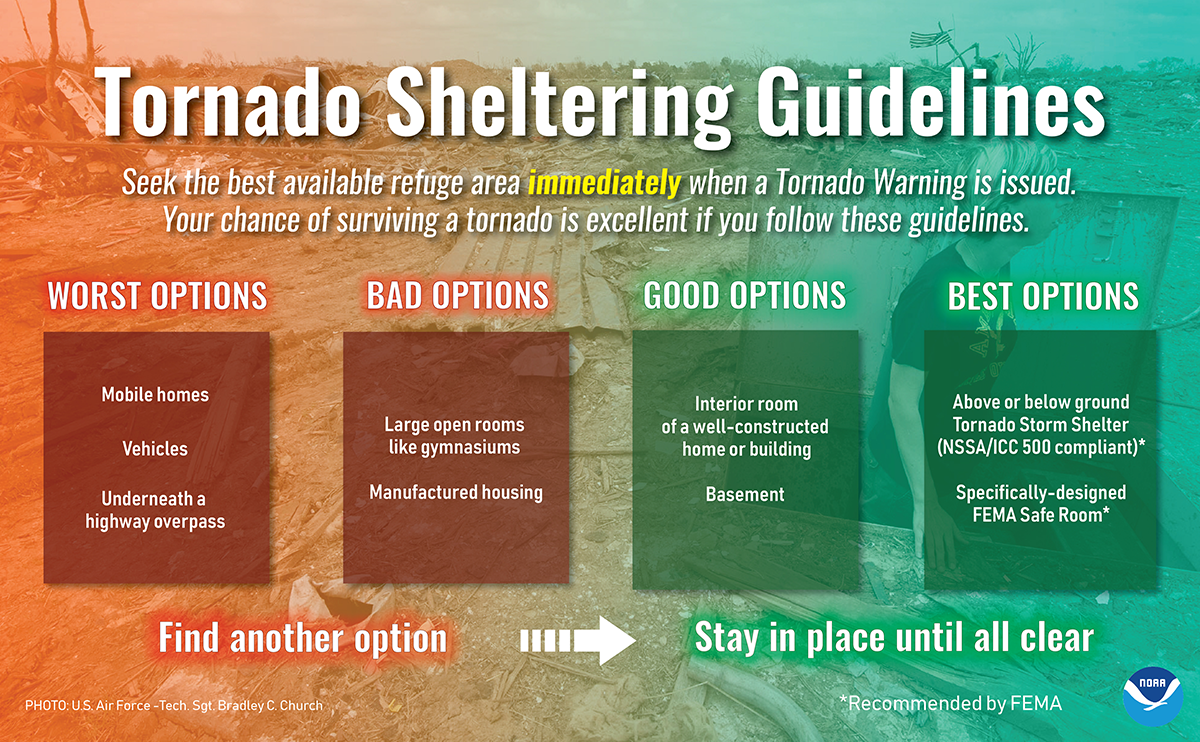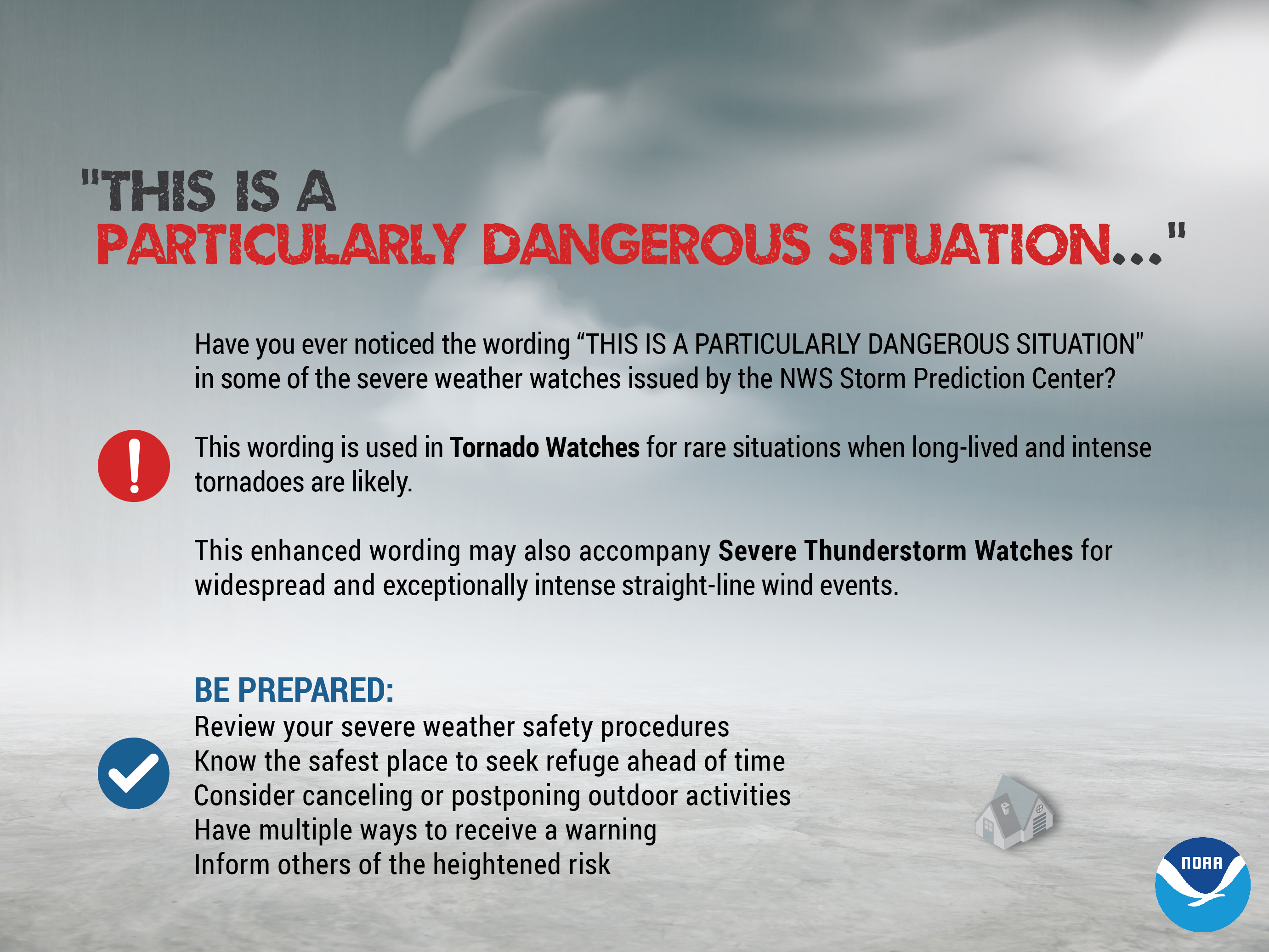Please help the National Weather Service spread these important safety messages on social media! Everyone is welcome to use the text and images provided below to help the NWS build a Weather-Ready Nation.
Facebook
What does being Weather-Ready look like? When it comes to tornadoes, it means knowing your ‘safe place’ and practicing going there well before severe weather arrives. Learn more tornado safety tips at weather.gov/safety/tornado
Twitter
What does being #WeatherReady look like? When it comes to tornadoes, it means knowing your ‘safe place’ and practicing going there well before severe weather arrives. Learn more tornado safety tips at weather.gov/safety/tornado

Facebook
Of all the many dangerous weather hazards, tornadoes are one of the most powerful and destructive. Although the details of their formation are still being researched, we do know the general steps. Watch this video for a quick science lesson. youtu.be/MMLRNW4UJOc
Twitter
Although the details of tornado formation are still being researched, we do know the general steps. Watch this video for a quick #science lesson. youtu.be/MMLRNW4UJOc
Facebook
You know to take shelter immediately if your area receives a Tornado Warning. But what makes a good shelter? Take the time now to figure out your options, and be Weather-Ready. weather.gov/safety/tornado
Twitter
You know to take shelter immediately if your area receives a Tornado Warning. But what makes a good shelter? Take the time now to figure out your options, and be #WeatherReady weather.gov/safety/tornado

Facebook
Imagine you’re relaxing at home...when all of a sudden a Tornado Warning comes through on your phone or NOAA Weather Radio. Where will you go to stay safe? weather.gov/safety/tornado
Twitter
Imagine you’re relaxing at home...when all of a sudden a Tornado Warning comes through on your phone or NOAA Weather Radio. Where will you go to stay safe? #WeatherReady weather.gov/safety/tornado

Facebook
During a tornado, seeking refuge in a vehicle or under an overpass is NOT safe. If you are outside during a tornado warning, the best option is to drive to a designated shelter, basement, or safe room. weather.gov/safety/tornado
Twitter
During a tornado, seeking refuge in a vehicle or under an overpass is NOT safe. If you are outside during a tornado warning, the best option is to drive to a designated shelter, basement, or safe room. weather.gov/safety/tornado #WeatherReady

Facebook
A tornado WATCH means BE PREPARED. A tornado WARNING or EMERGENCY means TAKE ACTION. If there is a tornado watch, pay extra close attention to the weather and be ready to act, because tornadoes are possible. If there is a tornado warning, find shelter immediately, and move to an interior room on the lowest floor of a sturdy building, because a tornado is occurring or will shortly. Avoid windows and cover your head to protect yourself from flying debris. Taking action early can help save lives! weather.gov/safety/tornado-ww
Twitter
Watch means BE PREPARED. Warning or Emergency means TAKE ACTION. weather.gov/safety/tornado-ww #WeatherReady

Facebook
Have you ever noticed the wording “THIS IS A PARTICULARLY DANGEROUS SITUATION” in severe weather watches? Here’s what it means.
Twitter
Have you ever noticed the wording “THIS IS A PARTICULARLY DANGEROUS SITUATION” in severe weather watches? Here’s what it means. #WeatherReady

Facebook
Do you know the severe weather risk categories? See the severe weather outlooks issued by the Storm Prediction Center spc.noaa.gov/
Twitter
Know your risk for severe weather? See the Storm Prediction Center @NWSSPC spc.noaa.gov/ #WeatherReady

Facebook
Tornadoes, large hail, strong winds, flooding, and lightning are all hazards associated with severe weather. Severe weather has been reported in all 50 states, so no matter where you are, you need to be prepared! weather.gov/safety/thunderstorm
Twitter
Severe weather can occur anywhere. Wherever you are, be prepared! weather.gov/safety/thunderstorm #WeatherReady

Facebook
Tropical cyclones spawn tornadoes when certain instability and vertical shear criteria are met, in a manner similar to other tornado-producing systems. Almost all U.S. tropical storms spawn at least one tornado. Learn how to stay safe from tornados at weather.gov/safety/tornado
Twitter
Tropical cyclones spawn tornadoes when certain instability and vertical shear criteria are met, in a manner similar to other tornado-producing systems. Learn how to stay safe from tornados at weather.gov/safety/tornado #WeatherReady

Facebook
Supercells are not the only types of storms that develop tornadoes. Did you know that there are multiple types of tornadoes that can form? Learn all about them in the infographic below, and visit weather.gov/jetstream/tornado.
Twitter
Did you know that there are multiple types of tornadoes? Visit weather.gov/jetstream/tornado for more info. #WeatherReady

Facebook
A tornado is a violently rotating column of air that extends from the base of a thunderstorm to the ground and begins as a funnel cloud. On a local scale, it is the most destructive of all atmospheric phenomena. nssl.noaa.gov/education/svrwx101/tornadoes/
Twitter
A tornado is a violently rotating column of air that extends from the base of a thunderstorm to the ground. On a local scale, it is the most destructive of all atmospheric phenomena. nssl.noaa.gov/education/svrwx101/tornadoes/ #WeatherReady

Facebook
A tornado WATCH means BE PREPARED. If there is a tornado watch, tornadoes are possible! Watches are issued by the Storm Prediction Center and are typically large, covering numerous counties and even states. Pay extra close attention to the weather and be ready to act. Preparing ahead of time helps to save lives! weather.gov/safety/tornado-ww
Twitter
A tornado Watch means BE PREPARED. Preparation helps to save lives! weather.gov/safety/tornado-ww #WeatherReady

Facebook
A tornado WARNING means TAKE ACTION NOW. If there is a tornado warning, a tornado is imminent or already occurring. Seek shelter immediately! Move to an interior room on the lowest floor of a sturdy building. Avoid windows and cover your head to protect yourself from flying debris. Acting early helps to save lives! weather.gov/safety/tornado-during
Twitter
A tornado WARNING means TAKE ACTION NOW and seek shelter immediately. weather.gov/safety/tornado-during #WeatherReady

Facebook
If your area is under a tornado warning, you may only have a few minutes to get to safety. Understand what to do if you’re in a tornado warning.
youtu.be/_5TiTfuvotc
Twitter
What should you do during a tornado warning? youtu.be/_5TiTfuvotc #WeatherReady
Facebook
If you are impacted by tornado damage, there are a few important things to remember. Listen to local officials, stay up-to-date on the forecast, contact loved ones (to let them know your status), and be mindful of debris (such as glass and nails) and downed power lines. Have a working radio with batteries, and use flashlights instead of candles to avoid starting fires. weather.gov/safety/tornado-after
Twitter
If you are impacted by tornado damage, here are a few important things to remember. weather.gov/safety/tornado-after #WeatherReady

Facebook
Tornadoes occur at any time of day or night. The nighttime hours are particularly dangerous because most people are sleeping, and it can be nearly impossible to see an approaching tornado. Keep Wireless Emergency Alerts enabled on your cell phone so you will be alerted in the event you’re in the path of a tornado. ready.gov/alerts
Twitter
Keep Wireless Emergency Alerts enabled on your cell phone. Find out more at ready.gov/alerts #WeatherReady

Facebook
Tornadoes occur at any time of day or night. The nighttime hours are particularly dangerous because most people are sleeping, and it can be nearly impossible to see an approaching tornado. A NOAA Weather Radio can alarm you when a Tornado Warning is issued. Keep the radio near your bed. You may not like getting woken up, but it could save your life. weather.gov/nwr/
Twitter
Get severe weather warnings at night with a @NOAA Weather Radio. weather.gov/nwr/ #WeatherReady

Facebook
Make a severe weather plan before you need it! Your family may not be together when a disaster strikes, so it is important to plan in advance: how you will get to a safe place, how you will contact one another, how you will get back together, and what you will do in different situations. To find out how, visit ready.gov/make-a-plan
Twitter
How will you stay in touch during a disaster? Make a plan! ready.gov/make-a-plan #WeatherReady

Facebook
What’s a watch? What’s a warning? Learn the difference between a tornado watch and warning in this short video.
https://www.youtube.com/watch?v=x3V3HZBs1Y4
Twitter
Learn the difference between a tornado watch and warning. https://www.youtube.com/watch?v=x3V3HZBs1Y4 #SummerSafety